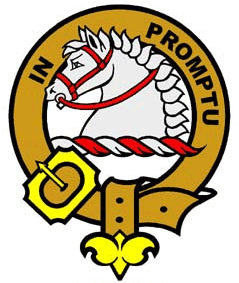Dunbar Clan
Dunbar Clan Crest: A horse's head, reined and bridled.
Dunbar Clan Motto: In Promptu (In Readiness).
Dunbar Clan History:
Gospatrick, grandson of Crinan, Thane of Dunkeld, Seneschal of the Isles, who had been made Earl of Northumbria, was driven from England back into Scotland by William the Conqueror, and was given the lands of Dunbar by the Scottish king, Malcolm III. In 1128, Gospatrick's son was acknowledged as Earl of Dunbar. In 1124, Patrick of Dunbar married Ada, a natural daughter of William the Lion, and became Justiciar of the Lothians. As part of her dowry, their daughter was given the lands of Home, thus establishing the line of the earls of Home.
The 9th Earl of Dunbar married Agnes, daughter of Sir Thomas Randolph, 1st Earl of Moray, and she is renowned for her spirited defence of Dunbar Castle against the English in 1338 in her husband's absence. On the death without heirs of her two brothers, Thomas, 2nd Earl of Moray and John, 3rd Earl of Moray, the estates and dignities were shared by Agnes and her sister Isabella, who was married to Sir Patrick Dunbar. George Dunbar, eldest son of Patrick and Isabel, succeeded his cousin as 10th Earl of Dunbar and his brother John became Earl of Moray in 1372.
Between 1290 and 1455, the earls of Dunbar were also earls of March, but this ended in the reign of James I, who, jealous of their great wealth, confiscated both lands and the titles.
Despite a long standing feud with Clan Innes, the Dunbars who settled in Moray and Caithness prospered. Branches include Boath in Nairn, Northfield in Morayshire, Hempriggs in Caithness, and Durn in Banffshire, The Dunbars of Mochrum in Wigtownshire also did well, the latter now being recognised as the chiefly house. Gavin Dunbar (1495-1597), younger son of Sir John Dunbar of Mochrum, was Archbishop of Glasgow and Lord High Chancellor of Scotland. Sir James Dunbar of Mochrum was created a baronet of Nova Scotia in 1694. On the death of his father in 1933, Sir James Michael Dunbar, 14th Baronet of Muchrum and a Colonel in the US Air Force, became Chief of Clan Dunbar.
William Dunbar (c.1460-1520) was born in East Lothian, was tutor of James V, and became a celebrated poet, noted for The Thrissill and the Rois.
Places of Interest:
Dunbar Castle. Dunbar, East Lothian. Held by the earls of Dunbar from the 12th century. In 1314, Edward II of England sheltered here having fled the Battlefield of Bannockburn. In 1338, it was defended against
the English by 'Black Agnes,' wife of the 9th Earl. Only ruins remain.
Mochrum, Wigtownshire. Land owned by Dunbars and later by the MacDougalls.
Elgin Cathedral, Elgin, Morayshire. Scene of a murderous brawl between the Dunbar and Innes families, known as the 'Bloody Vespers.'
Surname distribution in Scotland: The Dunbar surname is most commonly found in Highland (an amalgamtion of Caithness, Inverness-shire, Nairnshire, Ross and Cromarty, Sutherland and small areas of Argyllshire and Morayshire), Aberdeenshire (includes Kincardineshire and part of Banffshire), Angus (Forfarshire) and Moray (Elginshire).

